Are you pregnant and you want to train your ab muscles?
This post will teach you how.
Specifically, you’ll learn how to target the transverse abdominis muscles and the obliques no matter what trimester you’re in.
These are the muscles necessary to help treat and prevent diastasis recti.
Are you ready?
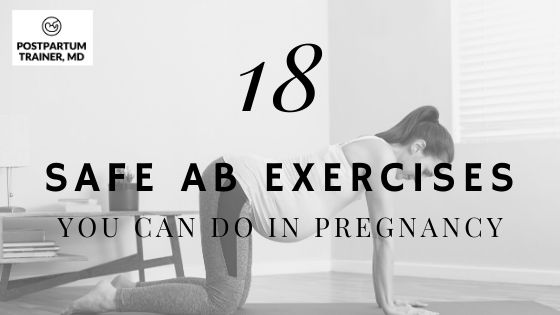
- Is It Safe To Do Ab Exercises in Pregnancy?
- Benefits of Strengthening Your Core During Pregnancy
- How Can I Strengthen My Transverse Abdominis During Pregnancy?
- Ab Exercises for The First Trimester of Pregnancy
- Ab Exercises For The Second Trimester of Pregnancy
- Ab Exercises for The Third Trimester of Pregnancy
- Ab Exercises To Avoid During Pregnancy
- What Are The Best Transverse Abdominis Exercises After Pregnancy?
- Final Words On Ab Training In Pregnancy
Is It Safe To Do Ab Exercises in Pregnancy?
Yes, it’s safe to do ab exercises during pregnancy. In fact, it’s recommended that you keep your core strong as you get into the 2nd and 3rd trimesters.
The most important thing is that you avoid doing traditional ab exercises like sit-ups or crunches.
Instead, you need to focus primarily on strengthening the transverse abdominis.
But before you do, make sure to get clearance from your healthcare provider before doing any type of exercise at all.
Benefits of Strengthening Your Core During Pregnancy
So why is core work so important during pregnancy?
For starters, your core gets significantly weak throughout the pregnancy.
This is a result of the muscles becoming stretched (from the growing uterus) and from not being used (since many women are afraid to do ab exercises).
By doing direct core work in pregnancy, you may see several benefits such as:
- Decreased risk of diastasic recti
- Improved posture
- Decrease risk of low back pain
- Increased postpartum recovery
What Is Diastasis Recti?
Diastasis recti is a condition where the muscles of your six-pack separate along the midline.
This leaves a gap in your abdomen that allows your intestines to protrude out.
The bulge can be fairly noticeable depending on the size of the separation.
How can I prevent my belly from separating during pregnancy?
Unfortunately, there is no definitive way of ensuring that diastasis recti doesn’t happen to you.
With that said, you might be able to decrease your risk by developing a strong core.
There core is composed of three important muscle groups:
- The Transverse Abdominis aka TVA
- The Obliques, and
- The Rectus Abdominis
Let’s go over them really quickly.
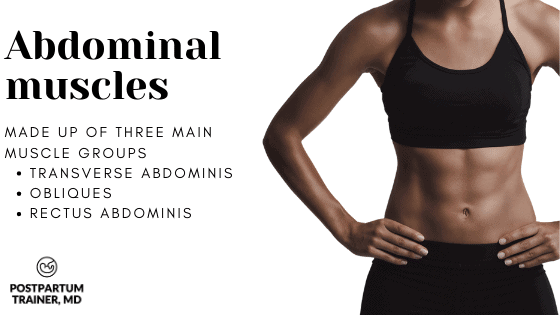
The Transverse Abdominis (TVA)
The transverse abdominis is the deepest abdominal muscle that wraps around your abdomen like a corset.
This deep muscle functions by compressing your ribs and internal organs while maintaining spinal stability.
In fact, the transverse abdominals play an important role in delivering your baby.
The Obliques
The oblique muscles lie on the sides of your belly. They are where “love handles” are located.
These muscles help you bend sideways, and rotate.
They are divided into external obliques and internal obliques.
The Rectus Abdominis
Lastly, the rectus abdominis is the “six-pack” muscle. They work to stabilize your spine and pelvis and allow you to flex your torso.
Of the three, the transverse abdominis is thought to be the most important muscle group in preventing and treating diastasis recti.
How Can I Strengthen My Transverse Abdominis During Pregnancy?
So how do you target your transverse abdominal muscles?
You need to do exercises that
- require spinal stability, and
- gently compress the core muscles along your obliques
The good news is, you don’t need to do exercises that “isolate” the TVA. All of the ab exercises listed below will target one or more core muscles while strengthening the TVA.
But here are the top three exercises that do focus most on the transverse abdominis that you can do in pregnancy.
The Best TVA Isolation Exercises You Can Do In Pregnancy
#1 Posterior Pelvic Tilts
The pelvic tilt is the most fundamental exercise in learning how to activate the TVA muscles.
It also helps to restore your hips and lumbar spine into a normal anatomical neutral position.
Here’s how to do it:
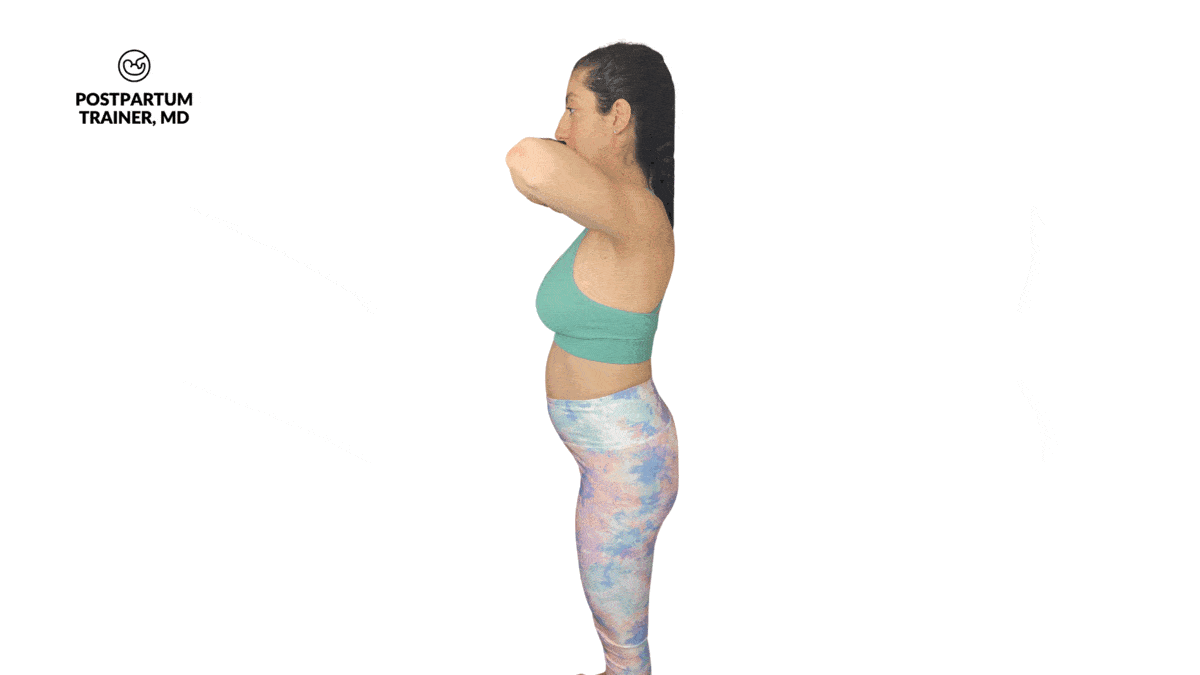
- Lie on the floor or against a wall with your knees bent and feet flat on the floor.
- There will be a natural arch in your low back- it is normal if your low back does not make contact with the floor.
- The goal of this exercise is to flatten out this curve so that your low back makes contact with the floor or wall.
- To start, focus, on driving your belly button down toward the floor or wall, and letting your tail bone rotate up toward the sky.
- Hold this position for 5 seconds.
- As subtle as the movement is, you should feel your transverse abdominis muscle activating.
- Repeat.
If you are in the second or third trimester of pregnancy – do this exercise against a wall.
Here’s how to do it:
- Stand with your back against a wall with your feet at least 6-12 inches away.
- Make three points of contact with the wall, your head, your upper back, and your butt.
- Again, there will be a natural arch in your low back.
- The goal of the exercise is to flatten out this curve so that your low back makes contact with the wall.
- Focus on driving your belly button back toward the wall while tilting your pelvis posteriorly.
- Once your low back is flat against the wall, squeeze your ab muscles and hold this position for 5 seconds.
- Repeat.
#2 Diaphragmatic Breathing
The second exercise to teach you how to isolate the transverse abdominis muscle is diaphragmatic breathing.
All it involves is taking purposefully deep breaths using your diaphragm muscle.
Here’s how:
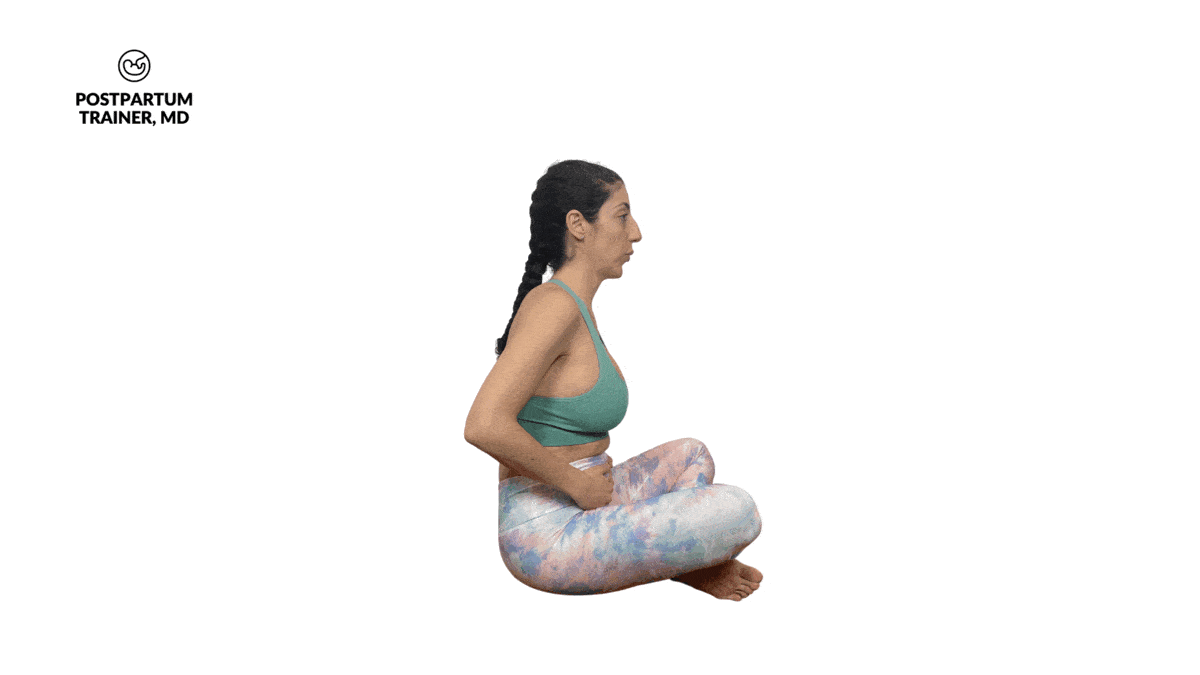
- Sit on the floor with your legs crossed.
- Relax your shoulders so that you aren’t holding any tension in your neck.
- From here, inhale as much as you can by expanding your belly to it’s fullest capability.
- As you are inhaling make sure that your shoulders do not move- you want the entire movement to come just from your belly.
- Hold the inhale for 1 second, and then slowly begin to exhale.
- Exhale, as much as you possibly can over 5 seconds.
- Focus on squeezing your TVA muscles (as well as the pelvic floor muscles) at the fully exhaled position for 3 seconds.
- Repeat.
#3 Cat Cow
The third exercise that can help isolate the TVA muscle is the cat cow. You may be familiar with this exercise from yoga.
Here’s how it looks:
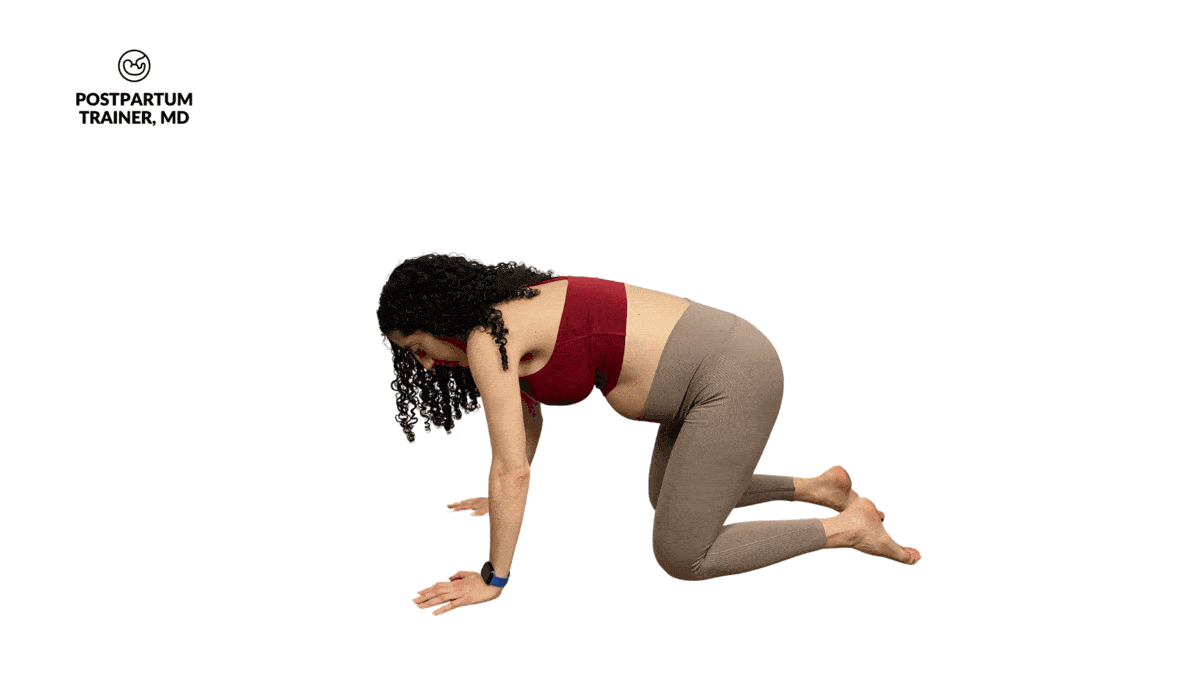
- Get into a quadruped position (on hands and knees) with your back as flat as possible.
- From here, begin inhaling as you arch your back and draw your head up toward the sky.
- Hold this position for 2-3 seconds.
- Then, reverse the movement by exhaling and completely rounding out your back and tucking your chin to your chest.
- In this fully rounded position, focus on drawing in your abdominal muscles and hold this position for 2-3 seconds.
- Repeat.
These three exercises can be practiced every single day throughout your pregnancy.
They will help
- Strengthen your core,
- Increase blood flow to your spine, and
- Promote spinal mobility
Now let’s go over other safe abdominal exercises you can do while pregnant.
These will target all of the muscles listed above, not just the transverse abdominal muscles.
Ab Exercises for The First Trimester of Pregnancy
Here are 5 great core exercises you can do in the first trimester.
As always, make sure your doctor says it okay, and avoid any exercise that feels funny or causes pain/discomfort.
Let’s get started.
Leg lifts
The first exercise is the sitting leg lifts. This movement will strengthen your lower abs, as well as the transverse abdominis.
Here’s how it looks:
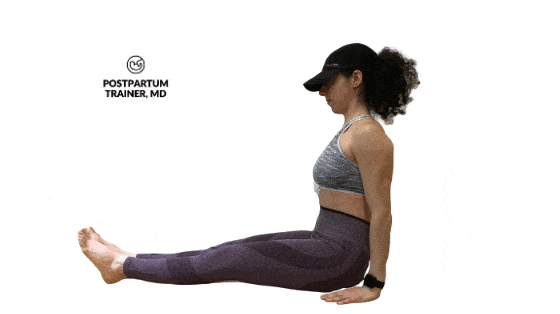
- Sit down on the floor with your legs straight out in front of you.
- Keep your feet together, and point your toes forward.
- Next, place your hands down by your sides. (The further down closer to your feet, you place your hands, the harder the exercise)
- Then, bring both of your legs up towards the sky while keeping your legs straight and feet together.
- Hold this position for 1 second and slowly lower back down.
To make this exercise easier, only lift one leg at a time while keeping the other foot on the floor.
To make it more challenging, bring your hands closer to your feet.
Do 8-12 repetitions per set.
In and Outs
The next exercise is the In and Out. This exercise will strengthen the lower abs as well as the transverse abdominis.
Here’s how it looks:
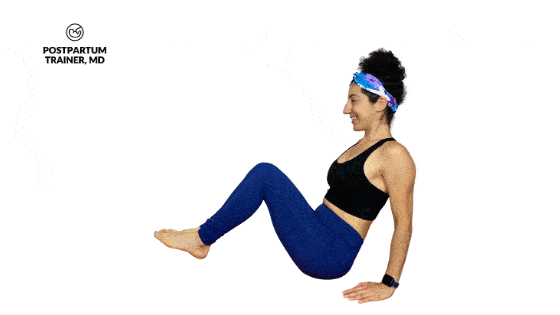
- Sit on the floor with your knees bent and feet flat on the ground.
- Place your hands down on the floor at your sides by your hips.
- Lift both feet off the floor to shift all your weight to your buttocks.
- Slowly extend your legs straight out as you lean back slightly.
- Do not let your feet touch the floor.
To make this exercise easier, you can elevate yourself onto a chair or a bench.
To make it more challenging, slow down the tempo to 3 seconds in, and 3 seconds out.
Do 12-15 repetitions per set.
Side Planks
Next is the side plank. This is one of the best exercises for strengthening the obliques and the deep abdominal muscles.
The good news is, this exercise can be scaled up or down depending on your preferred level of difficulty.
Here’s how to do it:
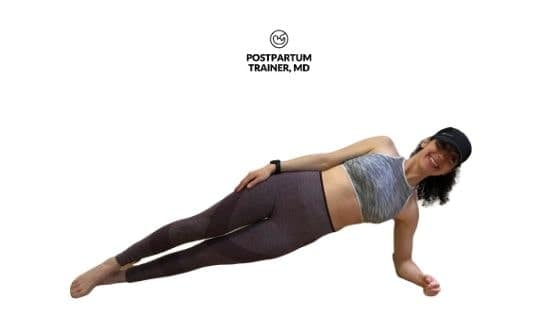
- Position yourself on your side, with your legs straight, and your hips extended.
- Prop yourself up on your elbow/forearm.
- Next, brace your core and squeeze your butt muscles as you elevate your hips off the ground.
- Stack your feet on top of each other, and make sure that your spine is straight.
- The only two points of contact on the floor should be your feet and your forearm.
To make this exercise easier, place the bottom knee on the ground.
To make it more challenging, prop yourself up onto your hand with your arm straight.
Do 20-30 seconds per side.
Dead Bugs
Next up is the dead bug. This exercise is performed while lying on your back and will activate the entire rectus abdominis and TVA.
Here’s how it looks:
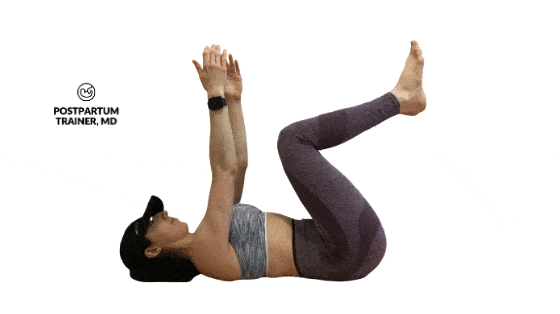
- Lie on your back with your knees bent, and feet off the floor.
- Next, raise your arms up toward the ceiling. This is the starting position.
- From here, posteriorly tilt your pelvis.
- Next, begin lowering your right leg as you extend it toward the floor. At the same time, you will bring your left arm up and over your head until it is also parallel to the floor.
- Hold this position for 2-3 seconds and focus on activating your TVA muscles.
- Do not let your low back come off the ground
- Slowly go back to the starting position and repeat with the opposite leg and arm.
To make this exercise easier, keep the knee bent of the working leg as you extend it down toward the floor.
To make it more challenging, place a foam roller or a long yoga block between the elbow and knee of the non-working side, and don’t let it drop.
Do 10-12 repetitions per side.
Up and Down Planks
The last exercise is the hardest. The up and down plank will challenge you in your ability to maintain core stability while moving.
Here’s how to do it:
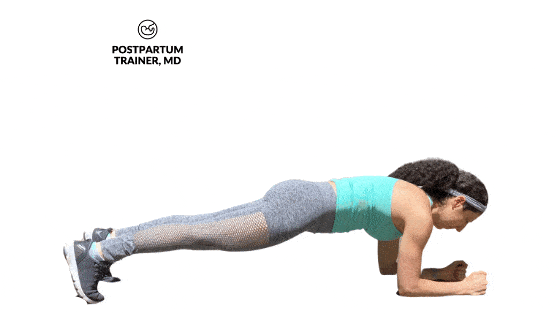
- Start in a forearm plank position, with your core tight and your glutes engaged.
- From here, transition into a straight arm plank, by extending one arm at a time.
- Try to minimize any side-to-side swinging, and do not let your hips sag or pike up into the air.
- You will then continue alternating between a forearm plank and a straight arm plank.
To make this exercise easier, you can do it from your knees, or you can widen your feet.
There’s no need to make this exercise any more challenging :).
Do 10-12 repetitions per set.
If you are looking for a complete 1st trimester core workout check out this post that has a 10-minute follow-along video.
Ab Exercises For The Second Trimester of Pregnancy
Alright so now you are between 13 and 27 weeks. Your baby is getting bigger, and you won’t be able to do some of the ab exercises listed above.
Thankfully, there are easier variations you can perform that will still give you a great ab workout.
Here they are.
Sitting Alternating Leg Lifts
The alternating leg lift is similar to the one above, except, you will be doing one leg at a time.
Here’s how it looks:
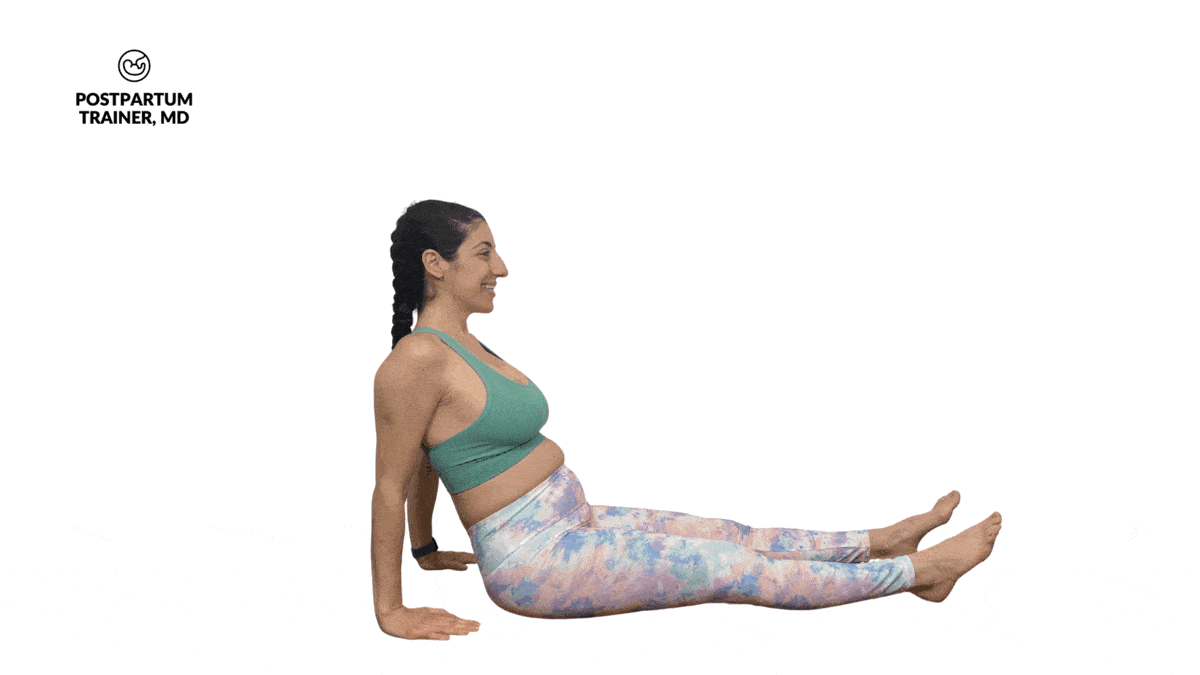
- Sit on the floor with your legs straight out in front of you.
- Keep your feet together, and point your toes forward.
- Place your hands down by your sides.
- From here, raise one of your legs up towards the sky, keeping your knee extended and toes pointed.
- Hold this position for 1 second and then repeat with your other leg.
- To make this exercise more challenging, bring your hands closer to your feet.
Do 8-10 repetitions per side.
Alternating In and Outs
Similarly, we can also do the In and Out exercise with one leg at a time or both legs (harder). This will make the exercise less demanding, and give you more space to accommodate your growing uterus.
Here’s how to do it:
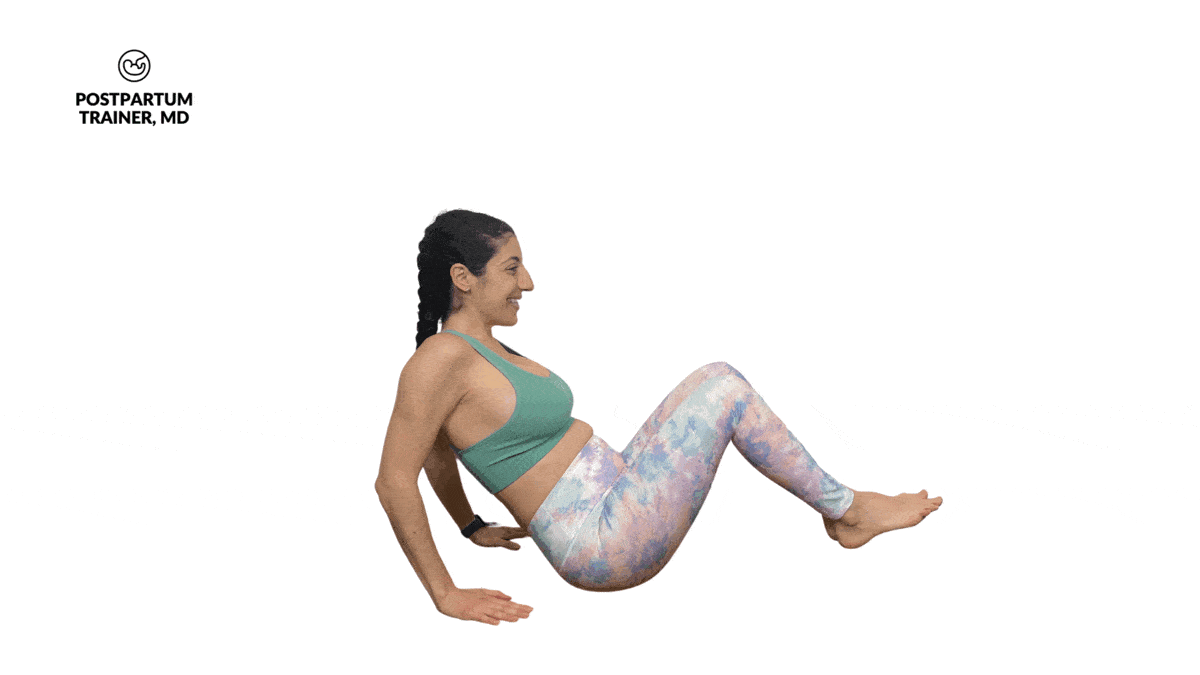
- Sit on the floor with your knees straight and feet out in front of you.
- Place your hands down on the floor, at your sides, by your hips.
- Lift both feet off the floor so that you are in a “V”.
- Bring one knee up towards your chest.
- Then slowly extend that leg straight out without letting your foot touch the ground.
- Now work the other side.
- Bring the other knee up towards your chest and slowly extend that leg straight out.
- Make sure you don’t let your feet touch the floor.
Do 8-10 repetitions per side.
Bird Dogs
The next exercise is the bird dog. This is a great movement to teach you how to stabilize your core from a safe position.
Here’s how to do it:

- Assume a quadruped position (on hands and knees) with a flat back.
- First, brace your core and posteriorly tilt your pelvis.
- Next, lift your right knee off the ground and begin extending that leg straight behind you.
- At the same time, lift the opposite arm and extend it straight out in front of you.
- Hold this position for 3 seconds while squeezing your glute muscles and keeping your ab muscles engaged.
- Repeat on the opposite side.
Do 8-10 repetitions per side.
Modified Side Planks
Next up is the oblique focused exercise – the modified side plank.
This exercise is performed exactly the same as the full side plank, except your bottom knee will remain on the floor.
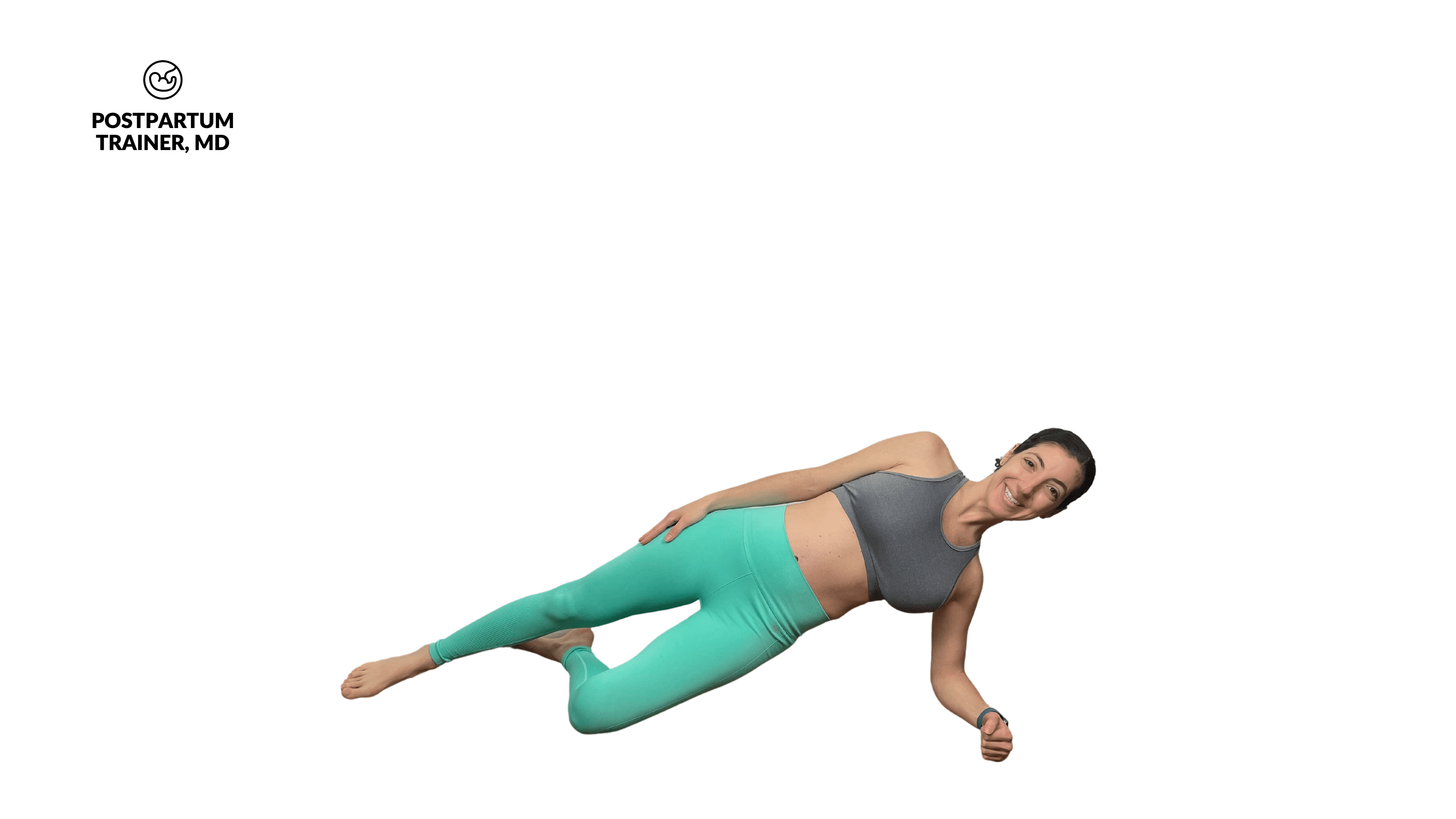
This is what it looks like:
Do 20-30 seconds per side.
Mountain Climber
The last second trimester ab exercise is the mountain climber. This exercise will target the lower abs while teaching you how to stabilize the TVA muscle.
Here’s how to do it:
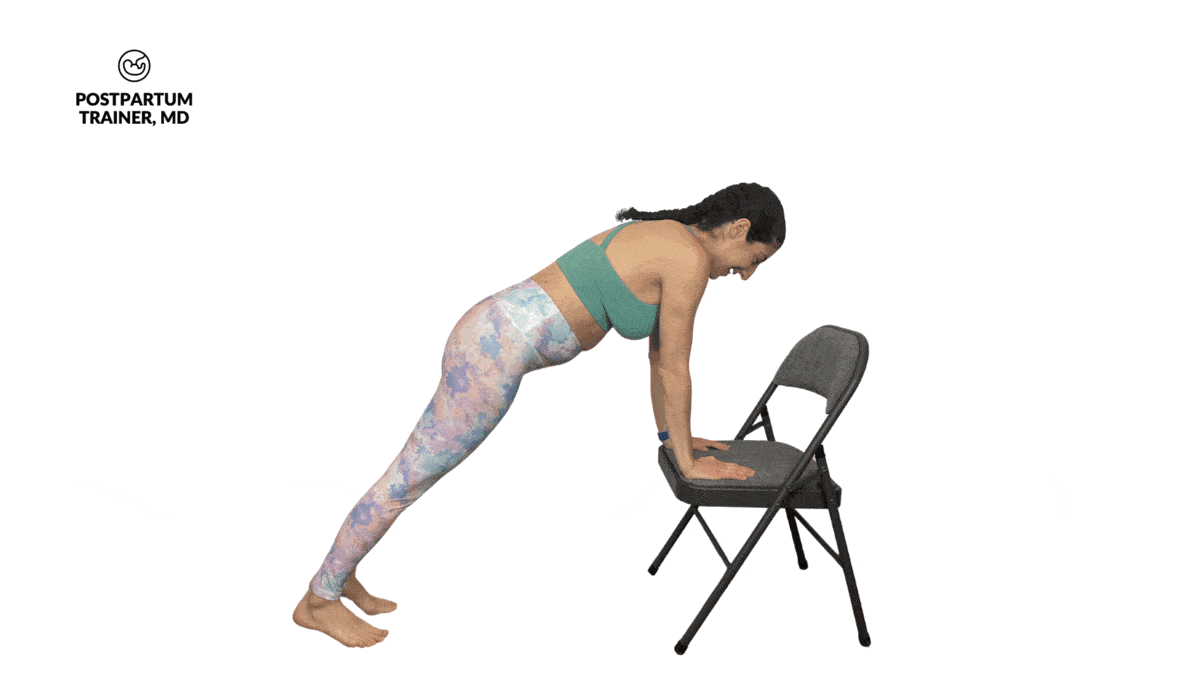
- Place your outstretched hands onto the chair about shoulder width apart.
- Make sure your hands are directly underneath your elbows, which are directly underneath your shoulders.
- Keep your back straight, your glutes activated, and your core engaged.
- From here, pick up one leg and bring that knee to your elbow.
- Don’t worry if you can’t make contact. Slowly bring that knee back down and repeat on the other side.
Do 12-15 repetitions on each side.
Ab Exercises for The Third Trimester of Pregnancy
Okay, now you’re in the third trimester. You’re uterus is growing at the fastest rate and your ab muscles are stretching.
This is an important time to strengthen the core.
Here’s how.
Quadruped Leg Extensions
The quadruped leg extension is a scaled back version of the bird dog. This exercise will help strengthen the core stabilizers while activating your glute muscles.
Here’s how to do it:
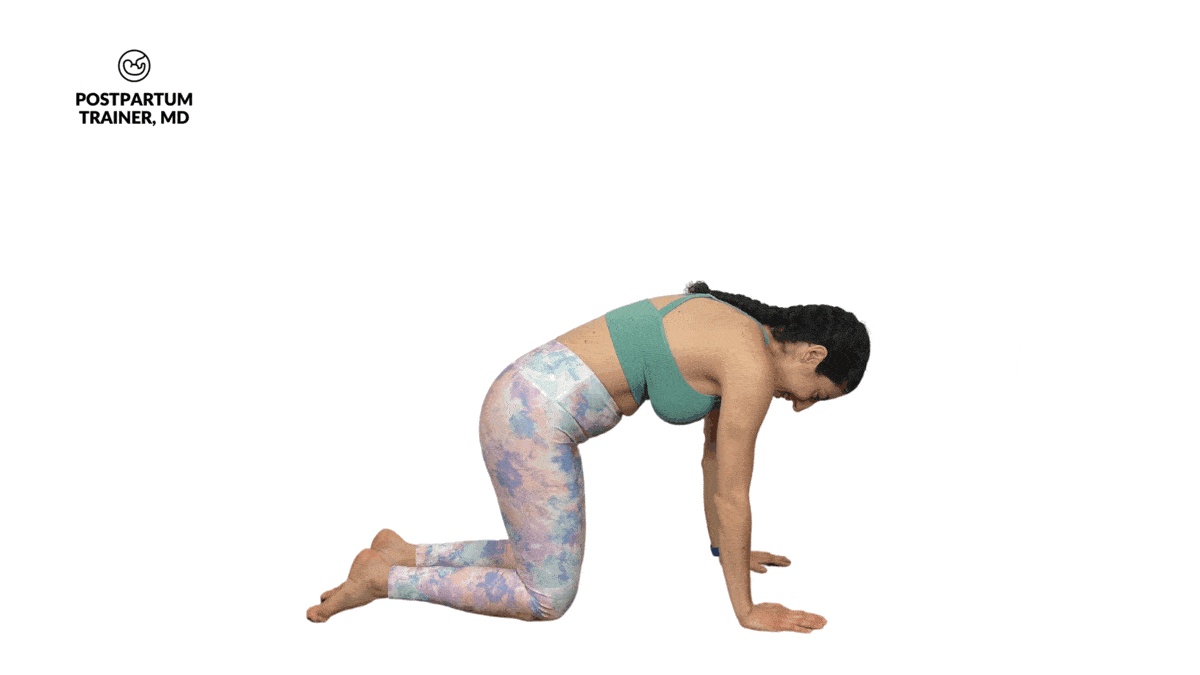
- Assume a quadruped position (on hands and knees) with a flat back.
- From here, brace your core and posteriorly tilt your pelvis.
- Then, lift one knee off the ground and begin extending that leg straight behind you.
- Hold this position for 2-3 seconds and return it slowly.
- Repeat for the desired amount of repetitions and then switch sides.
Do 10-12 repetitions per side.
Modified Plank Reps
The next exercise is the modified plank exercise.
You can do this exercise from the standard plank position (on your forearms) or in a tall plank (which is a bit harder).
Here’s how it looks:
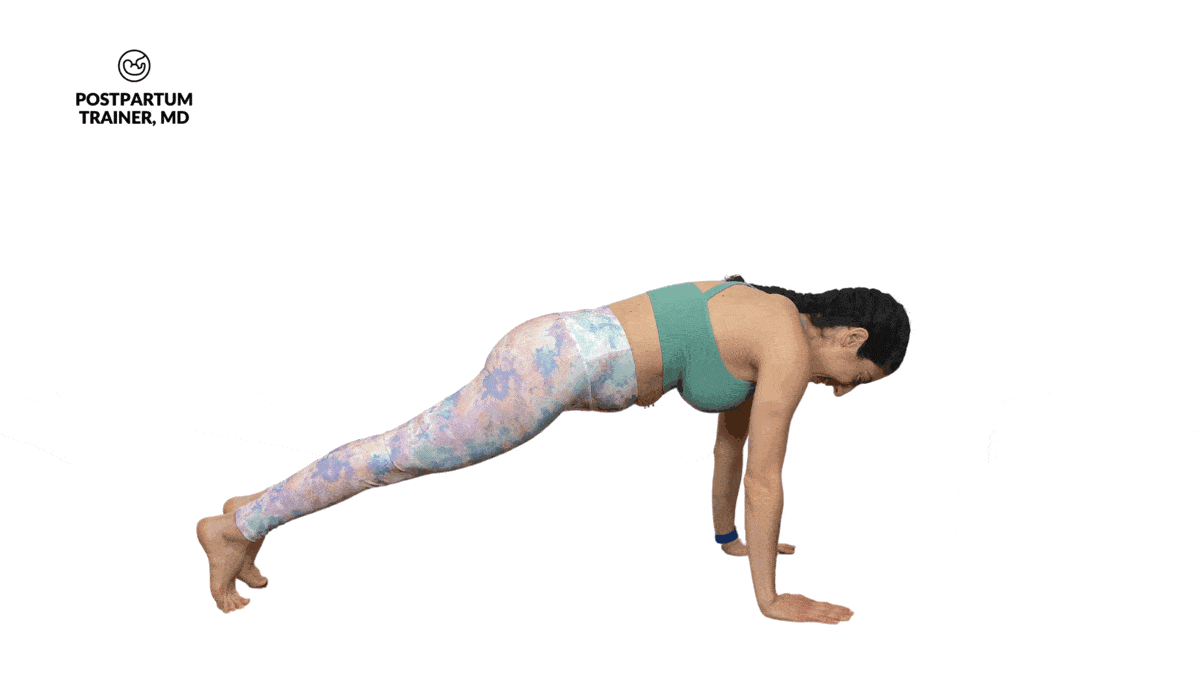
- Assume a tall plank position, which is the same as the starting position of a push-up.
- Make sure your hands are directly underneath your elbows, and that your elbows are directly underneath your shoulders.
- Keep your back straight, your glutes activated, and your core engaged.
- From here place one knee down on the ground.
- Slowly straighten that leg and then place the other knee on the ground.
- Keep your core tight the entire time
Do 10 repetitions per side.
Modified Side Plank (Both legs bent)
This variation of the side plank is the most scaled variation. Instead of having one leg bent on the floor, you will keep both legs bent on the floor.
Here’s what it looks like.
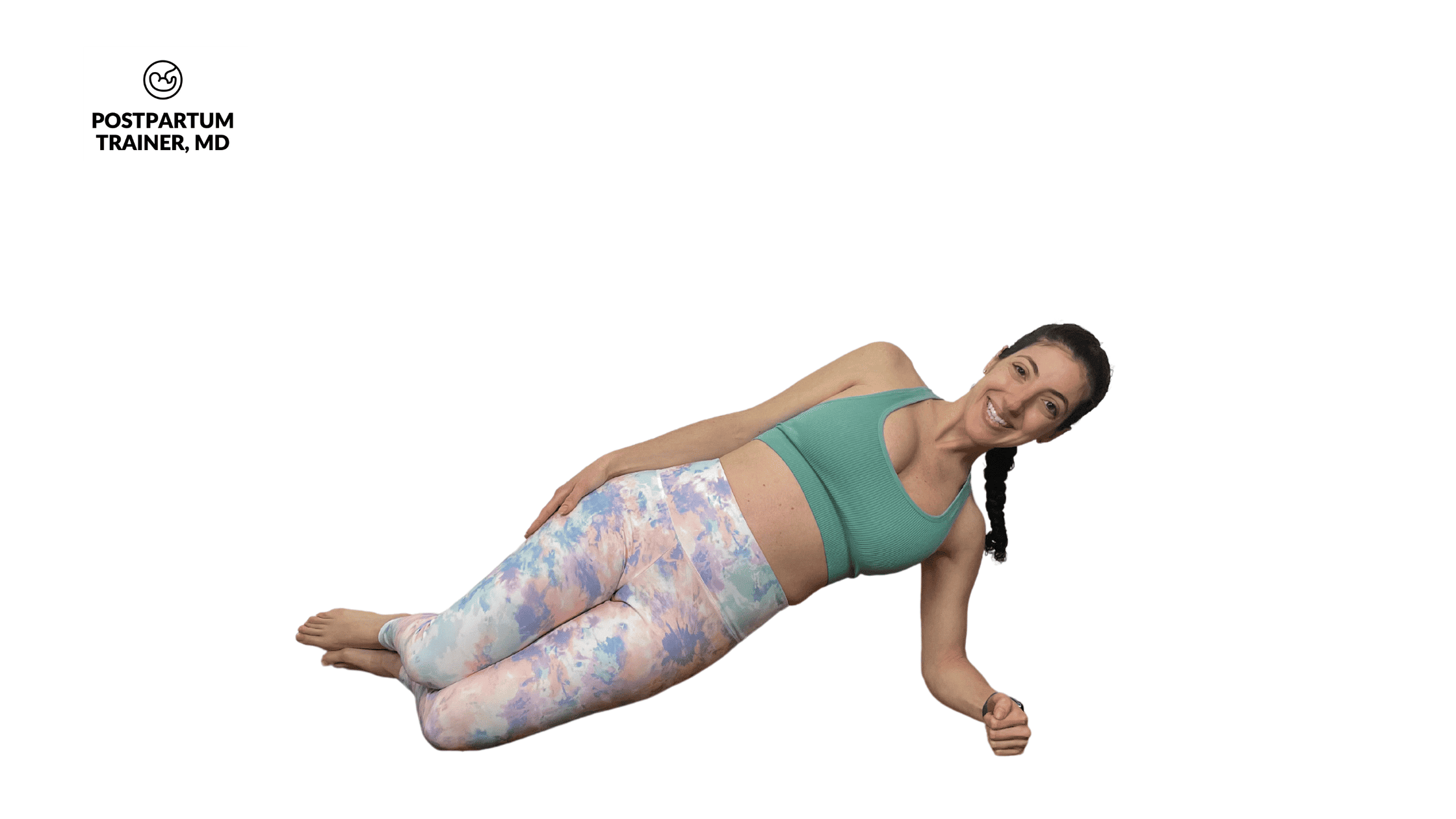
To make it more challenging, you can perform a tall side plank with your arm extended (hand on the ground rather than your forearm).
Hold this position for 15-30 seconds per side.
Pallof Press
The next exercise requires the use of a closed-loop resistance band.
(I recommend you pick up a set because they will allow you to do so many different exercises).
The pallof press will strengthen the oblique muscles and the TVA without you even having to move!
Here’s how to do it.
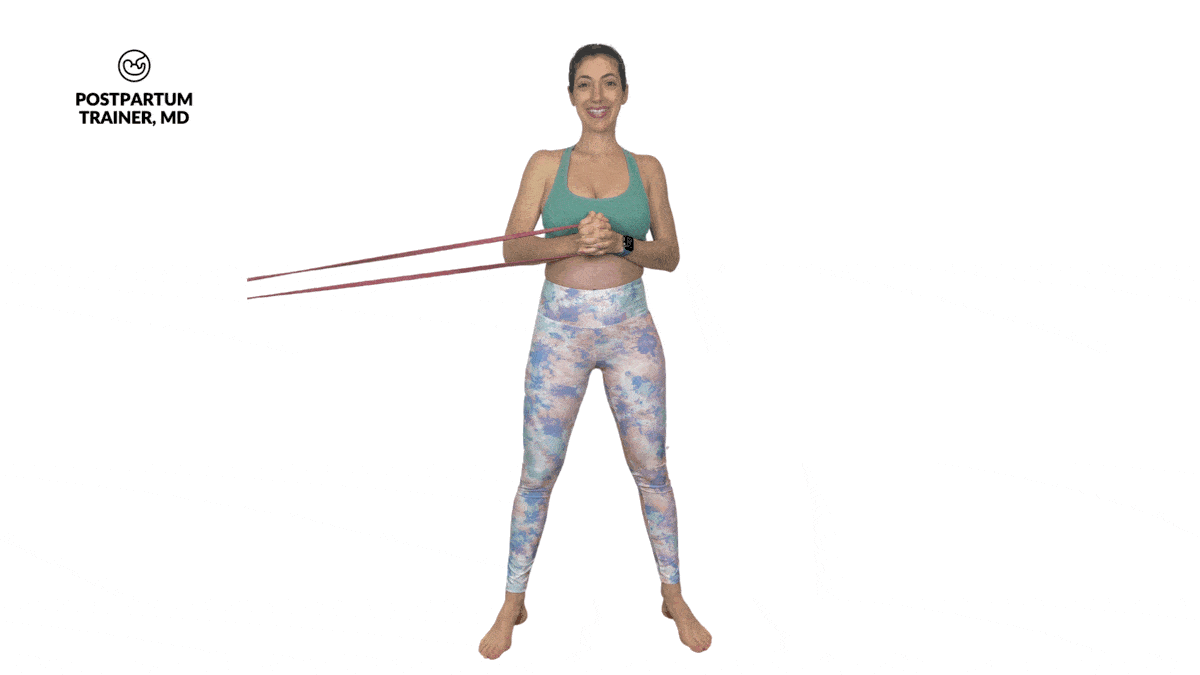
- Tie one end of a closed loop resistance band against a sturdy structure such as a pole or a horizontal beam.
- Interlock your hands on the other end of the band and hold it up by your chest.
- Step away from the pole to place the band on tension.
- Next, turn away from the pole so that you are facing away from it.
- Brace your core and press the band directly out in front of you.
- The band will try to rotate your torso. Do not allow this to happen.
- Hold this position for 3 seconds and slowly bring the band back toward your chest.
- Repeat.
Do 12-15 repetitions per set.
Farmer Carry
The last exercise is the farmer carry.
This is another great oblique and transverse abdominis exercise that doesn’t require any abdominal movement.
You will need to use a moderately heavy object such as a dumbbell, a small suitcase filled with books, or a backpack filled with books.
Here’s how to do it:
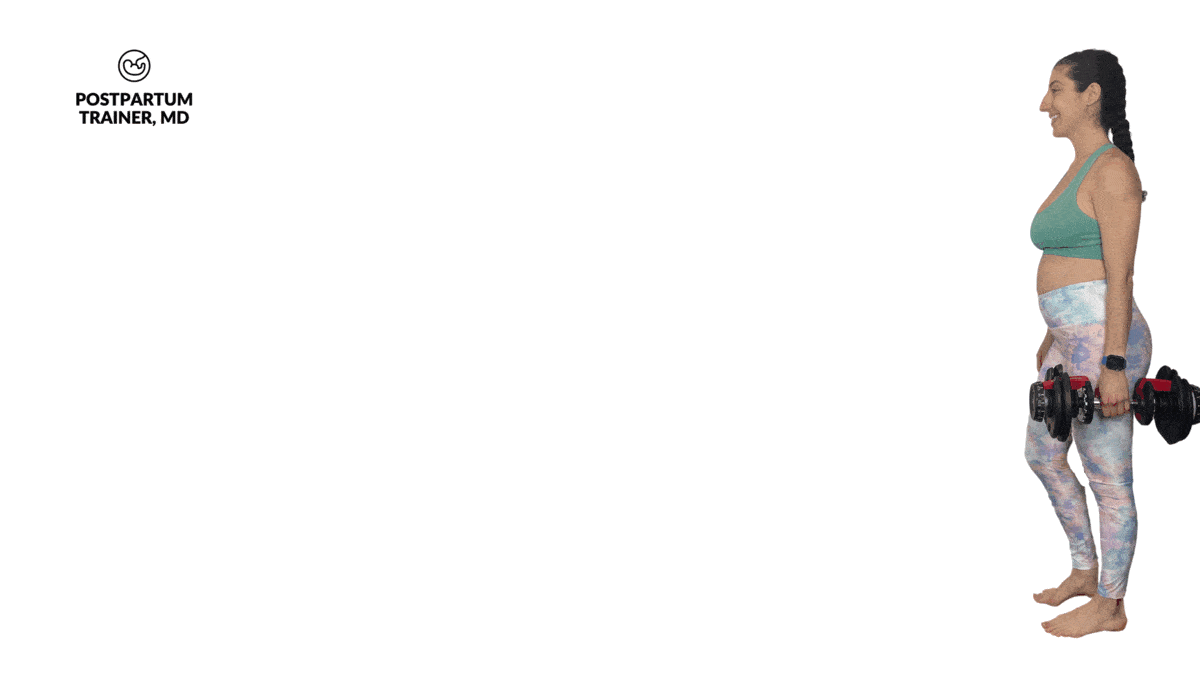
- Grab the weight with only one hand and hold it close to your side.
- Then, all you have to do is walk.
- The weight will try to bend your torso laterally, do not let this happen.
- Walk until your grip starts to give out.
- Repeat on the other side.
Walk until your grip gets tired on both sides.
Ab Exercises To Avoid During Pregnancy
Alright, so now you have a list of 18 safe ab exercises you can do in pregnancy.
The next thing you need to know are the exercises you should avoid doing. In general, the two main exercises you should avoid are
- Crunches, and
- Sit-ups
These exercises will place too much pressure on your rectus abdominus, which sits directly over your uterus.
This becomes especially important in the second and third trimesters. Thankfully, there are much safer ways to train your core in pregnancy.
Is it OK to twist while pregnant?
Similarly, it’s best to avoid any exercises or yoga poses that require a lot of twisting.
A common example is the Russian twist exercise. This movement can place too much pressure on the abdomen, or strain the uterine ligaments.
There are plenty of other low impact exercises you can do to strengthen the obliques.
Can you do stomach vacuums while pregnant?
The stomach vacuum is an exercise that many consider to be the best way to activate the TVA muscle.
To do it, you must suck your stomach in as much as you can and hold this position for time.
I recommend that you avoid the vacuum exercise as it can potentially decrease blood flow to your heart, and ultimately your uterus.
Doing a vacuum is different from bracing.
Is it bad to tense your stomach while pregnant?
No. It is normal to tense/brace your stomach muscles throughout the day. All of the safe pregnancy core exercises require you to brace your abdominals to a degree.
That is the only way to activate the important transverse abdominis. Just use good judgment and avoid exercises like the sit-up, the Russian twist, and the stomach vacuum.
What Are The Best Transverse Abdominis Exercises After Pregnancy?
What about postpartum? What are the best transverse abdominis (or ab) exercises after pregnancy?
I have an entire post on 100 Ab Exercises You Can Do After Pregnancy.
In fact, these exercises will help treat diastasis recti if you have it.
By the way, you can still get diastasis recti if you had a c-section. I have an entire post all about it.
Final Words On Ab Training In Pregnancy
So there you have it.
A list of safe abdominal exercises you can do in the first, second, and third trimester of pregnancy. As always, every woman is unique.
Make sure that your doctor gives you clearance before engaging in any exercise activity.
Now I want to hear from you.
Which exercise are you going to do first to build up your core strength?
Comment below and let me know!
Related Exercise in Pregnancy Posts
- How to Get Rid of Pregnancy Love Handles
- The Best Type of Planks to Perform During Your Pregnancy
- 21 Core Exercises To Do While Pregnant
Get Four Free Workouts To Help Strengthen Your Pelvic Floor & Heal Your Mommy Tummy!

Brittany Robles, MD, MPH, CPT
Brittany Robles is a full-time OBGYN physician, a NASM certified trainer, and a prenatal and postnatal fitness specialist. She holds a Master of Public Health degree in maternal health with a special interest in exercise and nutrition. She is also the co-author of The White Coat Trainer. Learn more about her here.
Sharing is Caring – Send This To A Mom In Need!

Is it only one set of reps or do you recommend a certain amount of times to go thru these excerises? I do core workouts already but looking to add more because I feel like I’m not doing enough.
Thanks!
Hi Angel,
Thanks for your comment. That is great that you already do a core workout.
As for these exercises, generally I recommend 2-3 sets of reps for each exercise listed. You know your body best, if you can’t do that many sets in addition to what you are already doing that is fine! Listen to your body and do what works for you. Something is always better than nothing!
Wow these are amazing. I’m so keen on keeping good fitness during pregnancy (even though I’m not yet pregnant) and I’ve always wondered how i was going to keep my core healthy, it was so weakened after my last pregnancy and took about 2 years to rehab while caring for twins at the same time.
I’m going to start familiarizing myself with these exercises so that I can continue them when I do fall pregnant.
Thank you so much for sharing your knowledge and expertise.